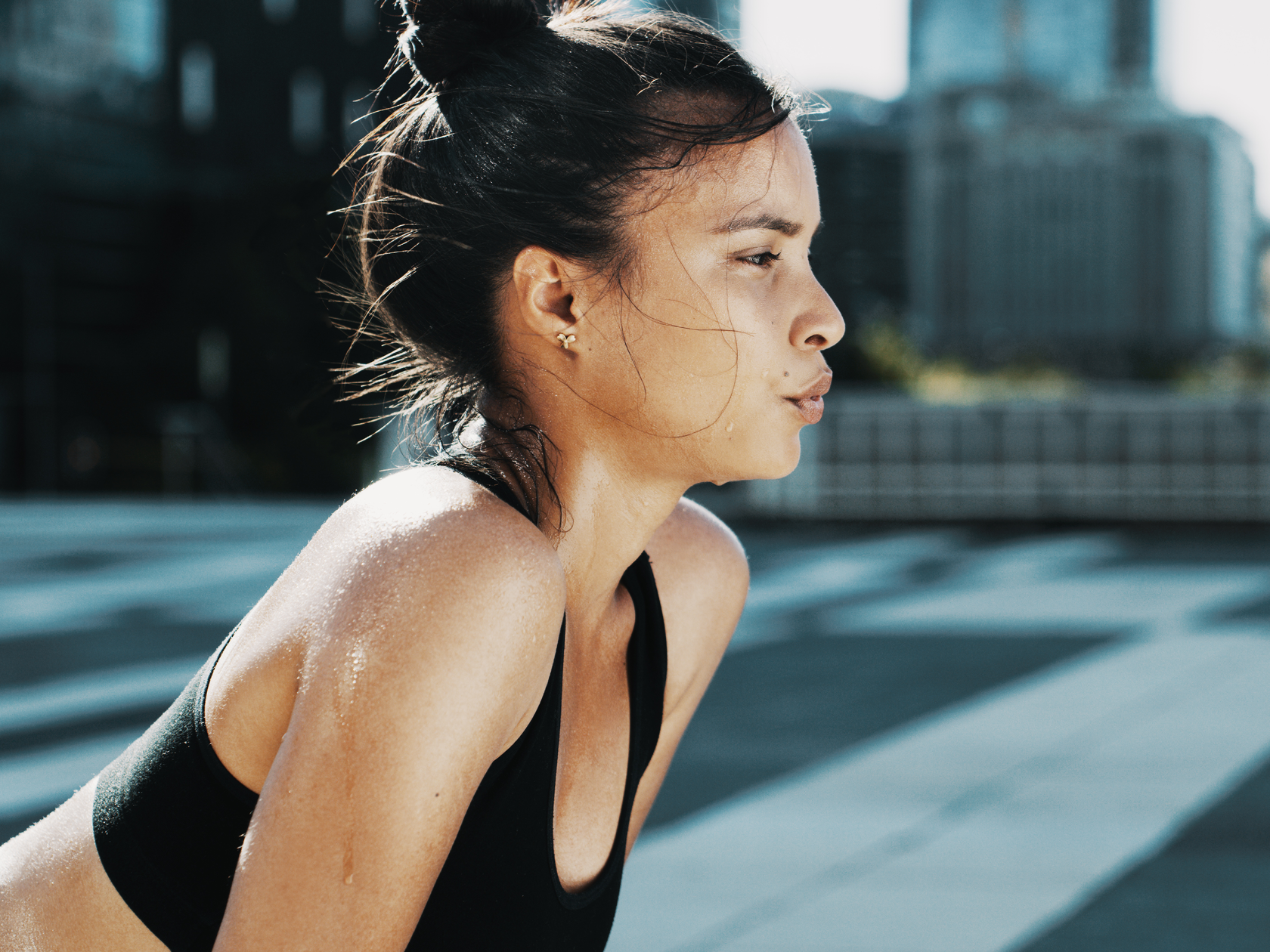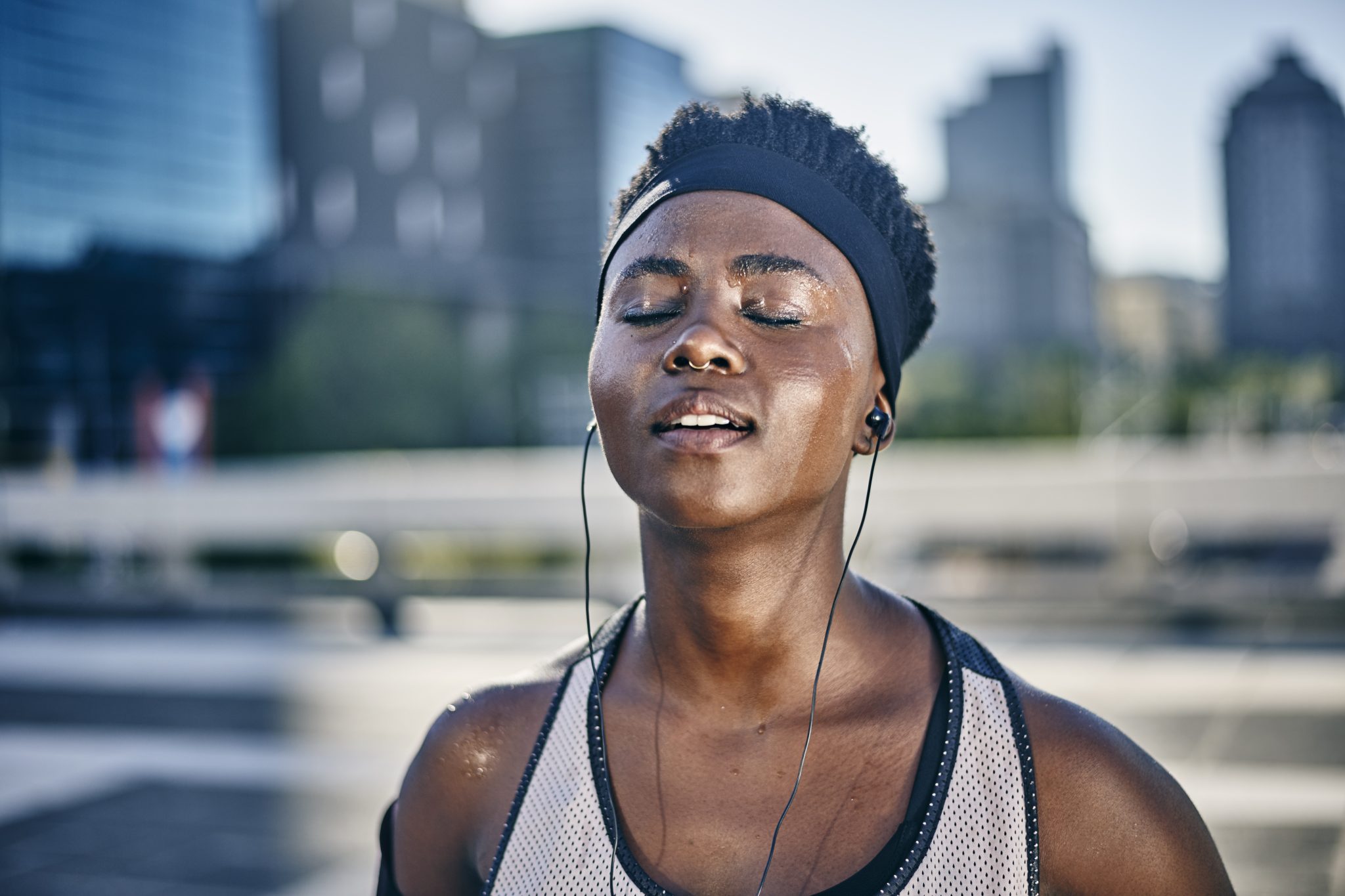We’re constantly reminding ourselves to breath during workouts. But it turns out, how we breath – i.e. belly breathing – can also help us hit our PBs.
“Just breathe through it” is a common phrase uttered reassuringly from our PTs and class instructors when we’re gasping for air on our 20th (okay, 10th) sit-up of the set. From finding a breathing rhythm on the treadmill to slowing it down during yoga practice, our inhale-exhale process is as variable to our workout as our kit. So, how can we use our most basic bodily function to unlock an untapped energy resource?
We take over 23,040 breaths on any given day, so you’d think we’d be pros at it by now, but Melike Hussein, founder of Breathzone, believes that there’s more to our respiration than meets the eye. “It’s not just about the basic intake of oxygen on inhale and the elimination of carbon dioxide,“ she explains. “Our respiratory system is directly connected to our brain stem and certain areas of the brain through neural pathways, creating a powerful connection between our emotions and respiratory patterns. Poor breathing habits – such as hyperventilation and holding the breath – are some of the key causes of breathlessness, not only during any physical activity but also in daily life. For example, if our breathing is too shallow, erratic or stops (breath holding), it is ineffective in allowing oxygen to travel throughout the body.”
Whether it’s pounding the pavement or lifting heavy weights, we asked the experts how to maximise our workouts with every breath we take.

What’s the difference between chest and belly breathing?
Although 80% of us breathe using our upper chests, Melike believes that this is a less than optimal way to intake oxygen if we want to get the most out of our body. “Chest breathing activates part of the nervous system controlling our survival mode, triggering or reinforcing stress and anxiety – whereas belly breathing activates the other part of the nervous system (parasympathetic) controlling rest and digest mode, effectively putting a break on that stress and anxiety,” she says.
Upper body muscles are short, tire out easily and aren’t as powerful as our diaphragm – which is the key muscle in driving our breathing. As a result, chest breathing is shallow, short and can only fill the top 1/3 of our lungs – limiting oxygenation of our cells and the elimination of carbon dioxide (a waste byproduct of our metabolism) from our body. If the diaphragm is not being used, the upper body muscles take over the entire breathing effort. Unfortunately, these muscles are not designed to take on such a demanding task (and carry out the action every minute of every day, year after year), it can lead to muscle tenderness and tightness, headaches, pain around the jaw, light-headedness and dizziness.
Whereas breaths from the belly are powered through the core muscles in our lower body and the diaphragm (the dome-shaped primary breathing muscle at the bottom of the ribcage). This is how we used to breathe as babies – an ability that we lost as we got older due to restrictive clothing, a habit of ‘holding the belly in’, poor posture, stress and an unconditioned diaphragm.”
You may also like
How to breathe to reduce anxiety: how coherent breathing can reduce stress
Why is belly breathing better?
While pushing our belly out and re-training a system that’s been on auto-pilot for years may seem like an alien concept, the long-term benefits are worth the effort. “The most efficient and anatomically correct pattern of breathing, perfectly aligned with the body’s skeletal and muscle structure, is belly breathing,” Melike tells us. ”It expands the lung capacity with air reaching the biggest, most oxygen-dense lower part, providing a steady supply of oxygen to cells and keeping the blood’s carbon dioxide levels at the correct balance.”
Although we tend to put our general aches and pains down to tough workouts, over-exertion or general wear-and-tear, experts believe that persistent tightness and tension in the shoulders and neck is typically a symptom of habitual chest breathers. “Chest breathing limits oxygenation of our cells which can lead to stiff, fatigued muscles and require a greater post-workout recovery time,” Melike says.
You may also like
How perfecting your breathing technique will help you to feel calm
How can belly breathing help me hit my PB?

If you’ve ever huffed and puffed your way through a workout and wished you could catch your breath, it’s time to engage your diaphragm. By expanding our lung capacity, we actively power-up the muscles that use less reserves, leaving us with more energy to tackle challenging exercises such as burpees.
“The same muscles that help us with our posture, balance and stability during physical activities are also the ones that help us breathe deeper into our body,” Melike says. “In belly breathing, the diaphragm is fully engaged, powering each inhale and exhale with support from other core muscles such as the pelvis, lower back, hips and abdomen. This is helping to condition them and enabling us to tap into their strength during our workouts. A steady flow of oxygenated blood to the muscles also prevents lactic acid build-up.” Which means you can say buh-bye to pesky cramps.
You may also like
Controlled breathing: the mental and physical health benefits of daily breathwork
How to belly breath for a better workout
Alan Dolan, aka The Breath Guru, practices belly breathing and “conscious connected breathing” daily. By performing the following breathing exercises every day for 6-12 weeks, belly breathing will become more automatic and subconscious, making it easier to tap into during your workouts.
1.Lay on your back on a flat surface and loosen any tight clothing around your belly.
2.Make sure that your head, neck and spine are aligned and your shoulders are down. Relax and close your eyes if this feels more comfortable.
3.Take one slow breath in and out through the nose. Feel what’s happening in your body – you should feel your sides, back and belly expand.
4.Put your hand on your abdomen and imagine a balloon in your belly, inflating with your inhale and deflating as you exhale.
5.Repeat at your own pace for a few minutes and make sure there is no movement in your chest.
Want effective at-home workouts? Follow @StrongWomenUK on Instagram for the latest workouts, delicious recipes and motivation from your favourite fitness experts.
Image credit: Getty
Source: Read Full Article
